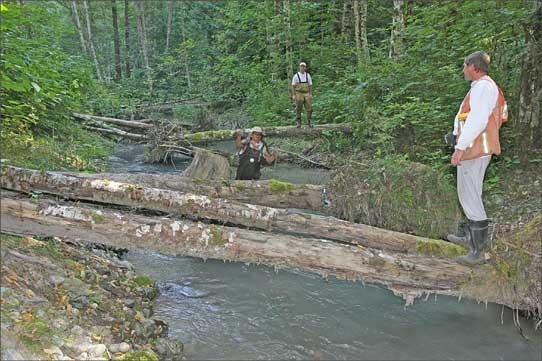By Vivian Moreau
There’s no trail through the bush to the Cheakamus River side
channel where workers are moving debris marooned from a 2003 flood back into
the water. But supervisor Peter Frederiksen of Triton Environmental Consultants
follows sounds of voices and a ratcheting cable puller through the forest to
the four-metre wide Gorbushka side channel to discuss rehabilitation efforts
with two workers.
“Messy channels can be a good thing as long as it’s not too messy,”
Frederickson says about the waters cluttered with logs, tree stumps and clumped
branches.
Triton employee Murray Metcalfe cranks a cable dragging a
two-metre stump into place in the stream as fisheries technician Allen Lewis
watches for snags.
“It’s a relatively slow process but the alternative would be to
walk in here with an excavator… and you can imagine the damage to the riparian
zone (that would cause),” Fredericksen says.
Tributaries of the Cheakamus River, the side channels are being
plumped up to entice returning coho, chum, pink salmon and steelhead to the
area and to provide nurseries for resulting fry and smolts. Part of a recovery
plan designed to help fish numbers rebound from the devastating August, 2005
sodium hydroxide river spill, Canadian National Railways is financing
rehabilitation of spawning side channels that were disturbed by the 2003 high
water flood. Hired by CN to implement the recovery plan that was finalized Aug.
15, Triton staff and contracted fish technicians are building woody debris
refuges for small fish to hide in and around before they migrate to sea.
“Juvenile fish like to have little breaks from higher
velocities of current to hide from predators and a refuge area where they can
sit in slow water and then dart out into fast water to pick up food items that
are drifting by,” Frederiksen says.
Steelhead are more difficult to build rearing grounds for than
coho or chum, preferring faster moving waters, Frederiksen says. The robust
fish may find nearby Mykiss channel, whose velocity can be controlled with a
gate valve, more to their liking.
Drafted by a consortium of First Nations, federal, provincial
and district agencies, with input from environmental and angling groups, the
recovery plan has provisions for both habitat and hatchery enhancements in
order to achieve clear numbers of fish by a certain date. Expected to take 10
years and costing millions of dollars, the efforts are aimed at bringing back
up to 160,000 chinook salmon, 128,000 coho, and 400 steelhead. Targeted numbers
for cutthroat, char, sculpins, lamprey and stickleback are less clear because
of lack of pre-spill inventory data on those species.
Fredericksen supervises a half dozen projects as part of the
Cheakamus recovery plan. Removing a concrete apron underneath Cheekye River
bridge will allow steelhead easier passage, as will clearing out the head of a
dry creekbed at Kilometre 11. His favorite project, Frederiksen says the
Kilometre 11 project will have the most visually dramatic effect. “It has the
most opportunity to create a lot of fish habitat right away.”
About 35,000 steelhead fry are being raised at Fraser Valley
Trout Hatchery in Abbotsford. Culled from eggs of 10 pairs of steelhead, the
hatchery’s manager says the fry are robust.
“They’re happy little campers,” said Dale Larson.
Divided into two groups of equal numbers of three gram and 1.5
gram fry, they need to reach 80 grams before release in May, 2007.
“We’re just having discussions right now as to where in the
Cheakamus to release them,” Larson said. “If it’s for replacement of population
we’ll likely put them upriver so they distribute throughout the whole system,
or another option is to put them in a side channel so they can be monitored as
they go out.”
Original targets for release of smolts had been 20,000. What
will happen to the extra number of smolts is also under discussion.
Pushing back through the forest to the access road from the
Gorbuska side channel, Frederiksen points out three-foot cedar saplings,
pioneer species, he explains. Thirty years ago Gorbushka channel had a
different course and after periodic flooding changed its direction a variety of
vegetation and trees took hold in the exposed area. Cedars and maples take over
as alders that initially sprung up are now nearing the end of their life.
Frederiksen notes how disturbances in nature sometimes have positive spinoffs
and makes the connection to the Cheakamus project.
“It was an unfortunate incident (the CN derailment and spill) but there are a lot of good things resulting in terms of recovery planning, strategies and cooperation between agencies. They all worked very hard to come up with some recovery strategies and targets that we can use to measure recovery.”




